- Kyogen actors traditionally begin getting stage experience from the age of two or three. Would you tell us what age you began performing from? Many Kyogen children begin their stage performances with the child’s role in Iroha (*), don’t they?
- I was two and a half years old when I first performed on stage and the play was Mahotsukai no Deshi (The Sorcerer’s Apprentice) in 1986. Men, wearing tights and naked from the waist up, and women play the role of brooms and I remember myself in the role of water, spinning around and around. I performed in Iroha about one year after that, when I was three.
- The Sorcerer’s Apprentice was a production of the NOHO Theatre Group led by your father Akira Shigeyama and Professor Jonah Salz of the Faculty of International Studies of Ryukoku University, which was founded in 1981 with the aim of creating a fusion of Japanese and Western Theater methods. It is a play based on a Goethe poem about a sorcerer’s apprentice who, in his master’s absence, attempts to use his immature sorcery to get brooms to do the cleaning for him with disastrous results. I find it very interesting that the NOHO Theatre Group’s production was your stage debut. It is as if that start was indicative of the artistic activities you are pursuing today. By the way, in Kyogen you were apprenticed not to your father, but to your grandfather, Sennojo, weren’t you?
- That’s right. My father had been apprenticed to my grandfather too, and after him, my senior, Yasushi Maruishi and myself became the only other two to be taught my grandfather’s unique kata (forms of movement and pose) and his distinctive phraseology. Because I was fortunate to have been taught that unique style, in my performances of the traditional Kyogen repertoire I want to continue to use Sennojo’s style. Since Master Sennojo has passed away, I must now begin to develop my own style and path, and to actively take opportunities to learn from others.
- I was once told by Master Sennojo that having a grandfather teach his grandson is an ideal situation in Kyogen. He said that a father tends to be very strict with his son, but to a grandfather a grandchild is endearingly cute in a different way, so he can bring a nice balance of gentleness and strictness. So, if your relationship with your grandfather was one of master and apprentice, what was your relationship with your father like?
- There wasn’t really much of a feeling that my father was my teacher. It was more like a relationship in which he was my senior that I was working together with in the same profession. And he was a senior that often had trouble learning his lines [laughs].
- Is that so?
- He did have trouble remembering his lines. So, when I had him perform in Marikouji, I will either have him perform as my opposite in traditional roles or, if it is in a new contemporary piece I will reduce the number of speaking lines for him. And even then, he says things different from the lines he is supposed to [laughs].
- In your Shigeyama family, you all do things in a variety of fields outside of the Kyogen genre. Your great-uncle Sensaku and your grandfather Sennojo were involved in collaborations with other arts outside of Noh-Kyogen, which was a practice that was taboo for Kyogen actors at the time, as they performed on the same stage as actors of Kabuki, traditional Japanese dance (Nihon Buyo) and new theater (shingeki). Entering the 1980s, Sennojo began what was called the “3G Project” involving performances with three famous actors from Italian Commedia dell’Arte, and a Swiss clown. Young members of your Shigeyama family have also acted on television dramas and in movies. Among these members of the Shigeyama family, I feel there is some difference in color between Sensaku’s eldest son Sengoro’s family (elder son Masakuni, second son Shigeru) and the family of Sensaku’s younger brother Sennojo (son Akira, grandson Doji).
-
I can’t compare myself with others, but it seems that the later born have a greater tendency to find new niches and do things people haven’t done before. In my generation, there is Sengoro’s son Masakuni (born 1972) and his younger brother Shigeru (born 1975) supports his activities. Sengoro’s younger brother Shime’s son Ippei (born 1979) and Motohiko (born 1975) are acting on television and in musicals. So, I think of things that I can do that won’t interfere with them. In that way, we naturally went in different directions.
Because, if we are doing the same thing, the one who comes later is at a disadvantage. There is not much difference in terms of talent, so the one who has been doing it longer naturally gains an advantage. Since I was watching Sennojo and my father to rather novel things like Beckett plays, I think I came to prefer things that were a bit esoteric rather than flashy things. - I think that in the world of Japan’s traditional arts, things are usually passed down in a more conservative way.
- Yes, they are. If the master says this is the way it’s done, usually everyone will say, “Yes,” and doing things that way. I think that with Sensaku and Sennojo it was a case where their interests and their characters were different from that pattern from the outset. Because, before that the trend was to do what the master said, but then both of them had started doing the things they wanted to do.
- Has the fact that these predecessors of your had pioneered new paths made it easier for you to try a variety of new things?
- Yes, it has been easier. Nobody got angry when I did new things. They would say it couldn’t be helped because, “He’s Sennojo’s grandson and Akira’s son.” On the other hand, people weren’t surprised by the things I did for that same reason [laughs]. I don’t have any desire to compete against other Kyogen artists or apply myself to the art more diligently than them. Rather than competing in that way, I want to do things that no one has done before.
- For elementary school, you went to an international school. For the child of a family in the traditional Japanese arts, it is certainly rare to choose a school where the education id done in English rather than in Japanese. Was that because of your father’s educational policy?
- My father didn’t like Japanese schools, and apparently he chose an international school because he didn’t want his son to go through Japan’s mandatory education system. But lately, it seems that there are a number of children of families in the Japanese traditional arts like Kabuki that have gone to international schools.
- So, it is a life where you are speaking English at school and when you come home you are speaking Japanese, isn’t it? In Kyogen, there is also old language that is not used anymore in contemporary Japanese. Did you ever have trouble with the language?
-
Since I didn’t have a childhood when I only spoke Japanese, it is hard for me to say, but a child will always adjust to the environment they are placed in and consider it natural, I believe. So, it felt like a natural environment for me as a child to be spending one-third of my time in English, one-third of it in Japanese and the other third sleeping.
In fact, I only went to the international school in elementary school (until 6th grade). For middle school, I moved to a school in Kobe, and that was at the time when the Great Hanshin-Awaji Earthquake struck Kobe, Osaka and Awajishima. My room was in a building that managed not to collapse, by the school was on Rokko Island [an island of land reclaimed from the sea where the earthquake caused liquefaction of the ground], so the school was closed for half a year after the earthquake. That caused me to be transferred to the Doshisha International Middle School in Kyoto that accepted children returning from overseas with international school backgrounds. - Did spending a third of your time in an English environment at an age when children are especially sensitive to language had any effects on your life as a Kyogen artist?
- It probably had some influence in terms of my personality/character development, but since I have never had any other kind of life, I can’t make comparisons. But, I guess it is because of my education in English that I am sometime chosen to give workshops for foreigners. Since I never went through the long process of learning the Chinese characters used in reading and writing Japanese, I can’t write Japanese without the aid of a computer, and since I had never done much reading in Japanese as a result, lately I am the one in the Shigeyama family who does the most reading by far.
- You also do “bilingual Kyogen” where the characters talk back and forth in Japanese and English, don’t you?
-
Bilingual Kyogen is something that my father started, and I do it when asked to, but it isn’t something I am particularly interested in personally. It is just performing Kyogen with the same exchange of line between the two characters, except that one is speaking in English and the other in Japanese, so it isn’t really doing something new [artistically].
In bilingual Kyogen the English lines are spoken a bit slower. If you speak at a normal speed, the rhythm of the words doesn’t match the timing of the movements. For that reason, the performer has to deliberately stretch out the intonations and modulation of the words. But in English, where you have successions of consonant sounds, you can’t stretch out the sound like you can in Japanese. In Japanese, when you stretch out the word, where is always a vowel sound in it, so the meaning remains clear, but in English where you will have two consonant sounds in a row, the meaning becomes unclear when you try to stretch it out. The result is that you can’t distinguish the individual words, so you can’t understand what is being said. - In other words, you can no longer hear the individual words with the English delivery, is it? But, in your case, having been educated in an English environment, isn’t it possible for you to make adjustments to overcome that problem?
- I have never made a serious attempt to re-construct a piece properly for bilingual Kyogen. I think that people who are really interested in it should create new plays specifically for bilingual Kyogen in order to make that difference in Japanese and English words an interesting part of it.
- In the extended Shigeyama family, the four sons in your generation have gotten together to create the “Wakamono Kai” group to do activities of your own. Your group’s first production was Hanagata Kyogen Shonentai (Star Kyogen boys troupe) in 1994. Then from 2000, you did “Shin, Gi, Tai Kyoiku-teki Koten Kyogen Suishin Junbi Kenshu-renma no Kai, TOPPA!” (Heart, technique, body – study and training group for preparation of the promotion of traditional Kyogen), and then from 2006 you began “HANAGATA” (*). These activities became the object of much attention because of the rarity of young traditional-arts practitioners in what would normally be their apprentice years to be forming such a group and engaging in such activities by themselves.
-
It certainly is rare for performers to be doing something like that from a young age. To begin with, it was Sennojo who proposed it. He told Shigeru, Ippei and Motohiko that it was about time for them to start a group. I believe Shigeru and Motohiko were about 20 at the time, and Ippei was about 15. I joined them two years later when I was about 13. It seems that Sennojo thought that if we were going to do it, it was best to start from a young age.
In the last few years of TOPPA!, I was writing a new work to be performed each year. There were five of us and each had their own interests and preferences, so I began to think that if I was going to continue writing new works, I should do it with a group of my own. - That is what led you to start the “Shigeyama Doji Writing and Directing Project” with “Hyakumanben” for presenting new conte stand-up comedy skits that you wrote and the “Shinsaku ‘Jun’ Kyogen Marikouji” project for presenting new works to become Kyogen traditional repertoire for the future, wasn’t it? The Hyakumanben pieces are performed by the Kyogen trio of you, Masakuni-san and Ippei-san. They include comedy skits on themes like men giving up their seats on the trains to others, and I find in them the kind of satirical spirit that Kyogen is famous for.
- With the Hyakumanben project we have done three productions since 2013, and with Marikouji I have written and presented two pieces since beginning in 2014. I started Hyakumanben because when I was writing new Kyogen pieces for HANAGATA, I had accumulated a good number of ideas that I thought would be interesting or funny to develop into a skit, but for some reason such as the rhythm or the need for [silent] pauses they wouldn’t work as Kyogen. Then I began to think that I would like to develop those ideas as conte comedy skits. In the [extended] Shigeyama family there are three of us working today who are writing new works, Senzaburo, Ippei and myself, and if you count one conte as a work, I guess I have written about 100, which would be the largest number in the family history.
- What is the difference between conte and Kyogen?
-
The biggest difference is the speed. Kyogen is irrevocably slow. That is why it is difficult to get laughs with things like a fast-paced story development. Also, the amount of text in a Kyogen work compared to
conte
is completely different. One three-part Kyogen performance will still have a rather short total script of about 5,000 to 6,000 characters in written Japanese, but an 80-minute
conte
performance it takes about 20,000 characters of script. So it is a difficult job to write that much.
I have stated publicly before that I like the conte group RAHMENS. They use simple stage art and mix in pantomime to create full and seamless comedy theater. If I hadn’t discovered their performances, I don’t think I would have wanted to begin writing conte . - It seems to me that there is a difference in the way props are used in conte and Kyogen. In your Hyakumanben conte you sometimes use contemporary props like cell phones and books, but do you use props like that in new Kyogen works?
- It would be all right to use them, but if you bring out a cell phone in Kyogen, it carries with it a realm of [contemporary] meaning, so it is difficult to use one in the normal sense of just a prop. Because of the gap between a cell phone and traditional Kyogen, just bringing one out would be an unexpected act that would probably cause surprise and laughter in itself. Another difference between Conte and Kyogen is that Kyogen has certain traditional conventions that make some types of actions and movements difficult to use. For example, since there are certain conventions for how you show the act of fighting, it looks strange if you use movement other than the conventional ones in a fight scene, so you can’t act out a fight freely.
- Are there some comedy skit ideas that are better suited for conte or for Kyogen?
-
I always write down notes when I get an idea. There are always lots of things that come to mind that I think are possible good comedy material but not sufficient in themselves for a full-scale work. But when I feel that three or so such ideas can be connected and I find a theme to connect them, then they can become a work. And, if the binding theme is not one that is bound to a particular time or era so that, even if it is not a hundred years, it will still be relevant and interesting several decades from now, then I will make it into a new Kyogen work for my Marikouji series.
With my Marikouji works, what I am concerned about is three things: is it something that can be performed anytime, can it be performed by anyone, and will it remain interesting and amusing for some time. I write them to be works that are structured so they don’t require any detailed directorial instruction or stage notes, so that any Kyogen artist who reads the script can envision right away how it should be acted out and with what kind of movements.
For a work to last dozens of years, it needs to have some real substance related to the era it portrays in order to have the strength to last. It is not that I am writing with some clearly defined theme, but I do bring in some kinds of contemporary material to the contents when I write. For example, with Imawa no Fuchi (On the verge of one’s last moment) that I wrote in 2014, the theme was suicide. Among the developed nations of the world, Japan has an exceptionally high suicide rate, but it is often said that the thing that makes one person decide to kill him or her self is often something that is no such serious matter to other people, isn’t it? In my play I had a rich man whose wife had run away and a man who is being chased by debt collectors meet by chance when they come to the same cliff thinking to commit suicide. As they talk to each other about what has happened to them, they begin to realize that neither of their problems is really so bad that it is reason to die, and they but end up deciding not to commit suicide. That’s the story. And the theme that I brought into the play for my second Marikouji production, Oniga Sakaya (Orge’s Bar) was hate speech. - Was it your experience performing Kyogen as a child that attracted you to comedy like the conte and Kyogen you are doing now?
- That’s part of it, and it’s also because I think comedy is cooler than serious theater. I like it when the audience has a good laugh and when they leave the theater they say, “That was fun. Let’s go have dinner,” and as they are eating dinner at a restaurant, someone says, “Today’s play was certainly fun, wasn’t it? But, by the way, what was the story about?” [laughs] I want to write that kind of light play that has no really substantial content. If possible, I don’t want to write the kind of play that causes some people say, “I saw that play, and it changed my life.” Rather than creating plays that change other people’s lives, the direction I want to go in is creating things that are purely enjoyable. I prefer that kind of lighter, less emotional or compelling style. That is why I am personally not motivated to write things that don’t have laughter in them.
- It isn’t easy to get an audience to laugh and people who try to create comedy use a number of styles, such as situation comedy, character development and comical pause and movement. How is it with you?
- I believe there are about 40 different ways to get an audience to laugh. And I think it is a matter of mastering about three of those methods or else trying to be a comedian who can use any method. Since I feel that I am a person who doesn’t have any really strong individuality when it comes to acting or writing, I don’t think I could compete by narrowing down my focus to a few specialized methods. So, I want to be someone who can use any method with some degree of proficiency.
- It seems to me that you are able to try a variety of new things because you have as your base the art of Kyogen. What are your thoughts about the potential of Kyogen as an art?
- Even if you don’t try to look at it in a favorable way, I think that you can say that when you compare it to the other traditional comedy arts of the world, Kyogen is one that with a high level quality. It is a very simple and versatile form of comedy. Kyogen portrays not only stories of a variety of different types of people but also different eras. Although this may be a generality, I would say that, basically, the broader the appeal in comedy, the weaker the comic effect will be. Things that appeal to the general public are things dealing with a subject that anyone can relate to, so its comic effect is limited. If it is something that only makes three people in a hundred laugh, it is something that is especially funny to those three people. Because Kyogen is an art that has been performed for six or seven hundred years, it has evolved into a comedy form that appeals to a very broad audience, which makes things difficult (because it is not the intense appeal of the chosen three), but at the same time, I believe you can say that its very longevity means that it has continued to function as a very good entry-level style of comedy.
- I believe finding ways to adapt to the new era is a very serious issue for Kyogen and other traditional arts. The young members of your Shigeyama family are trying new things, but do you think new [Kyogen] works are necessary to develop new audience?
- Well, I would say it is a kind of insurance. When the trend in society is one of strong conservatism, there is an increase in the sentiment that the traditional arts need to be preserved, and support for those of our family who are dedicated to the main traditional line of Kyogen like Sengoro, Masakuni and Shigeru grows. At times like that, I tend to be seen as a dropout. On the other hand, when the tendency in society is to say, “Who needs this old stuff?” newer works like mine become useful. In this way, we maintain diversity to make sure that not all of us die out, that some of us survive to carry on. Our [extended] Shigeyama family is not one where we all pull together with all our apples in one barrel [laughs]. I guess this is the basic stance.
- Last year you staged a production of the comedy The Merry Widow (Die lustige Witwe), and in February this year you acted as supervisor for a Kyogen style opera Così fan tutte (written and directed by Yonedanji Katsura) with music by the strings soloists of the Deutsche Kammerphilharmonie Bremen (Bremen German Chamber Philharmonic). These productions seem to be the direct result of new directions pioneered by your grandfather (Sennojo) and father (Akira).
- Yes, you could say that. My father suggested that I do it, and I said, “Yes, why not?” So, I did it. It was quite difficult doing opera. When you are directing it, there are so many people involved, with the characters and orchestra and all. We are used to the small-scale composition of Kyogen, so it was quite a difficult undertaking.
- In the world of Kyogen the role of director is quite different.
- Yes, because it is a role that doesn’t exist in Japan’s traditionally performing arts. In the last few years I have found that I am not really suited to the role of director, I believe. When I watch a professional director at work, not just the finished work (performance) but the whole process of creating a production, I think it is amazing. I feel it is truly the work of a professional. That ability to read everything from the original work and then bring it to the stage is something that is beyond my experience and imagination. So, in the future, I want to leave the work of directing to others while I concentrate on writing and acting. However, I also find writing very painstaking and labor-intensive, and I also find myself thinking at times why I have to go through all that work [laughs]. But, I do enjoy seeing my works performed when they are done.
- You sometimes perform overseas as well. Do you find a difference from the way Japanese audiences respond, the way they laugh?
-
As a whole, since foreigners don’t have the preconception that Kyogen is a traditional art, I feel they generally respond to it and laugh more naturally. Since Kyogen is basically dialog plays, there is naturally a gap in terms of understanding of the dialog, which is a difficulty. So, I guess eventually we will have to think more about what is the best form to present Kyogen in overseas. As traditional arts, Kabuki and Noh have a very distinctive and impressive visual aspect, so it is a question of what we in Kyogen need to do in order to stand as a stable third member of the act [laughs].
My father’s generation was very positive toward things foreign, so they wanted to do Beckett and they had a strong desire to take their own arts to the West and have them acknowledged there. Having been raised by people of that generation, my natural response was to turn my eyes inward more. In the process of being told that I could speak English and I was bilingual, I came to think that the first priority should be to deal with the reality that many people who know the Japanese language still don’t know anything about Kyogen. - Kyogen doesn’t use stage art to any degree, and although there is the costume, it is still an art that is reliant almost solely on the actor’s body [and voice] alone. Overseas, the language barrier may be an obstacle, but it seems to me that there is a great potential in the things that can be expressed solely with the body and with the voice.
- Yes, there is. You could call it a form of [panto]mime, and it is a very convenient tool that enables you to express things without using props. Because, even without props, you can take advantage of people’s imagination to have a [imaginary] thing disappear and then bring it back again later. Perhaps we can say that the very fact that we don’t depend too much on props, Kyogen [technique] fits in well with comedy plays.
- What kinds of things do you want to do going forward?
- I feel it is about time for me to begin doing full-fledged conte comedy.
- Does that mean doing conte with people other than Kyogen artists? Because if you only do conte with Kyogen artists it will always take on Kyogen conventions?
-
That’s right. Kyogen artists aren’t really good as stage actors, so in the end they have to depend on their Kyogen techniques and conventions. So, I want to use real [stage] actors and work up performances seriously in the rehearsal studio.
This year I will be acting in a production of Hideki Noda’s play Sandaime Richard (Richard the Third) directed by Ong Keng-sen. In March we started rehearsals in Bali, and it is quite a long-term contract that will continue through performances in the autumn. I don’t know how much leeway I will have, but I hope to meet some interesting actors through this project. It is more difficult that people might imagine to find actors who will do interesting work when used in a comedy. Since Kyogen is an all-male art, it is only natural that I have not written any plays that involve female actors. So, in order for me to grow as a writer, I think it will be good for me to write things that involve women as well.
Doji Shigeyama
From new Kyogen to stand-up comedy and opera, the creative power of Doji Shigeyama
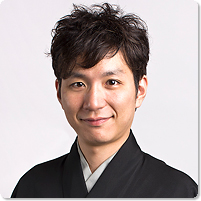
(C) Doji Company
Doji Shigeyama
Kyogen artist of the Okura School. Born in Kyoto in 1983. Studied Kyogen as an apprentice of his grandfather, Shigeyama Sennojo II . First performed on stage in 1986 in the play “The Sorcerer’s Apprentice” staged by his father Akira Shigeyama’s NOHO Gekidan company. He studied at the Kyoto International School (Jr. high school, high school). In 2006, Doji performed the difficult Kyogen stage, Tsurigikitsune as a demonstration of his acquired skills as an apprentice. In 2013, he wrote and directed his first “Hyakumanben” conte piece, and in 2014 he began his “Shinsaku ‘Jun’ Kyogen Marikouji” performance group to present new Kyogen plays he writes. In other wide-ranging activities he has used his English speaking skills in appearing regularly on the NHK language program “Purekiso English” and also performs as an actor in movies and works as a stage director, while also directing opera and is active with his chori poet group “ chori Doji.”
Doji Company
http://dojicompany.jp
Interviewer: Kazumi Narabe [Journalist]
Iroha
This is a Kyogen play often performed by young Kyogen family boys. In it, the father tries to teach his son the hiragana Japanese phonetic alphabet using the traditional I-ro-ha sequence of the 48 characters but the child scoffs at him and refuses to try to learn to read the characters. The father then demands that the son learn by repeating after him as he reads the characters. But the child then proceeds to copy even the voice of his irritated father until the father gets mad and pulls his son to the ground. The son then stands up and does the same to his father. This skit is also said to be a parody of the lessons where a master has his apprentice learn his lines by copying the master’s vocalization and movements precisely. The interest lies in the sight of the clever child using his irrelevant responses to make fun of the adult and the sight of adult gradually becoming irritated.
HANAGATA
One of the Shigeyama family performance series started in 1976 as a study series for the younger members of the family named “Hanagata Kyogen Kai.” At the time, the members were Sengoro (Masayoshi at the time), Shime (Shingo at the time) and Akira, and now it has become the group of their sons as “HANAGATA” consisting of Masakuni, Motohiko, Shigeru, Ippei and Doji, who use it to perform experimental works.
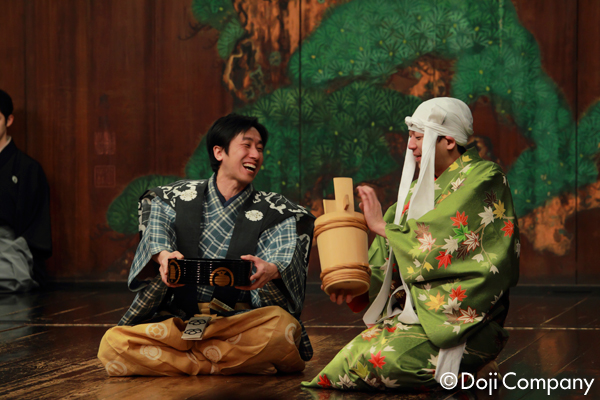
Morohaku ga Uchi
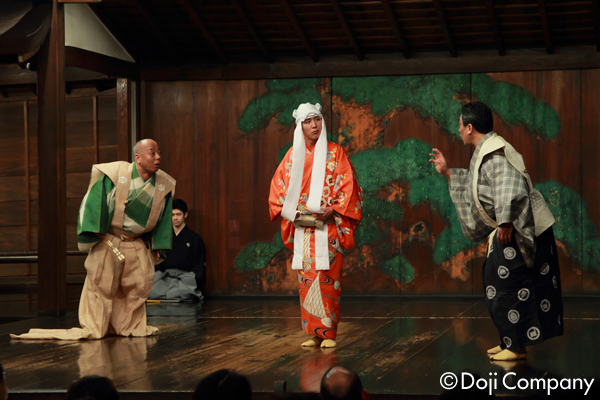
Imawa no Fuchi
Marikouji – Ichi no Maki (Vol.1)
Mar. 16, 2014Ooe Nougakudou
(C) Doji Company
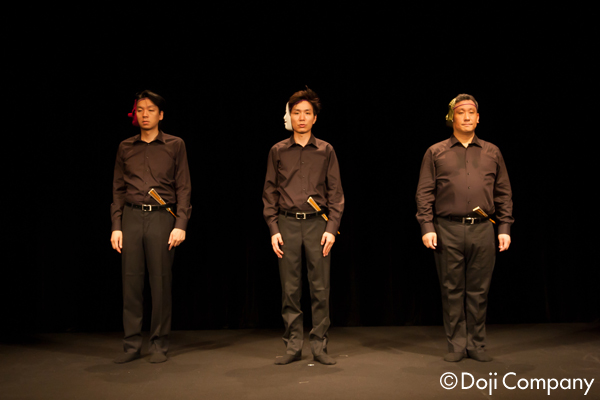
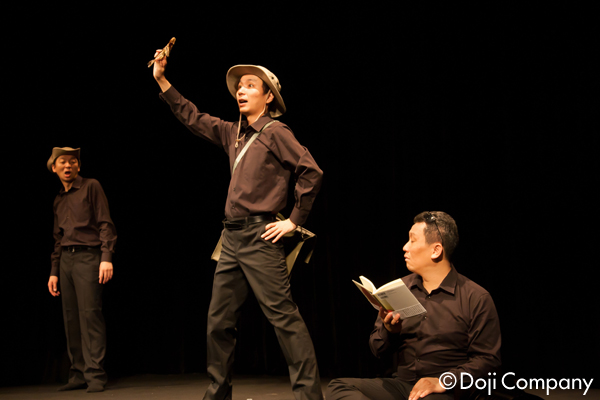
Hyakumanben vol.3 “Talking Book”
(Aug. 7, 2015 at Kyoto International Community House)
(C) Doji Company
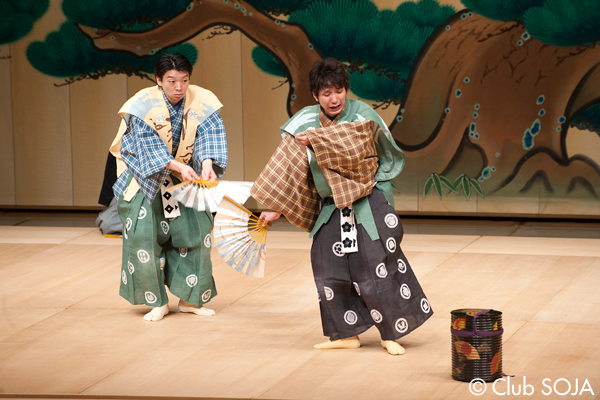
Kyogen play
Busu
Related Tags

